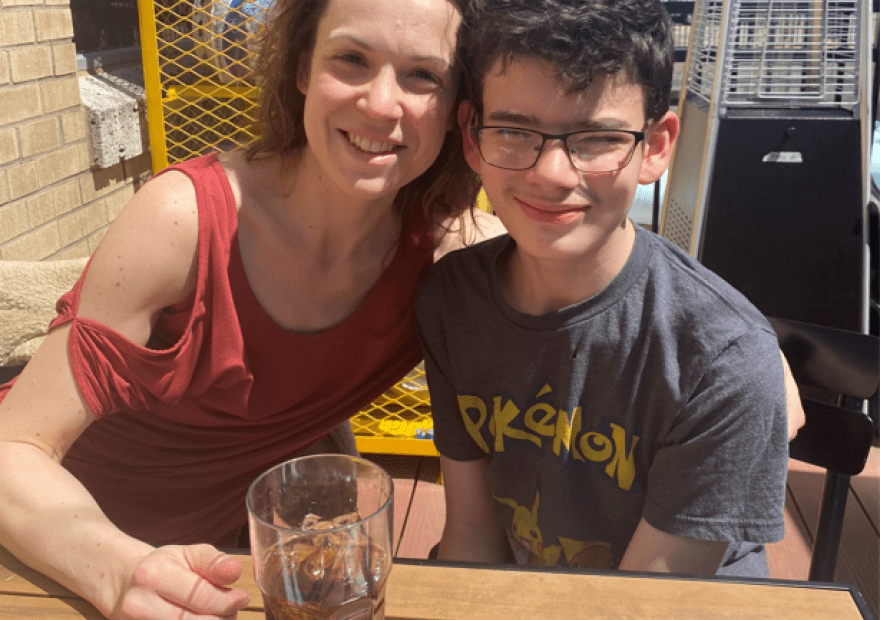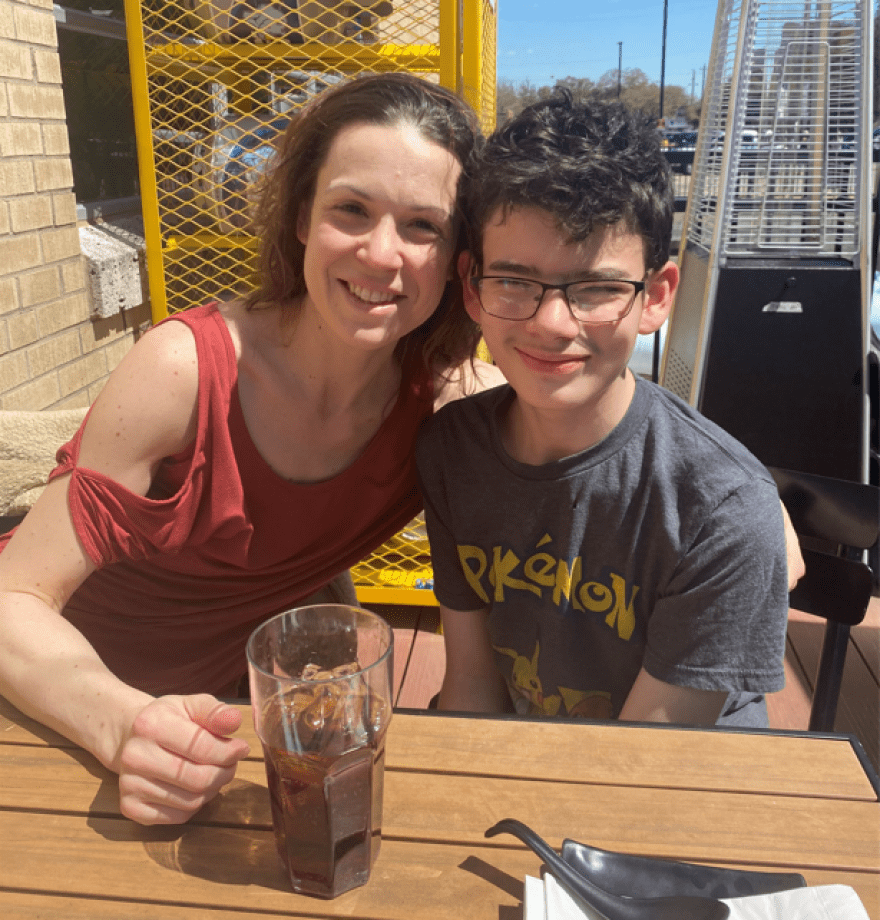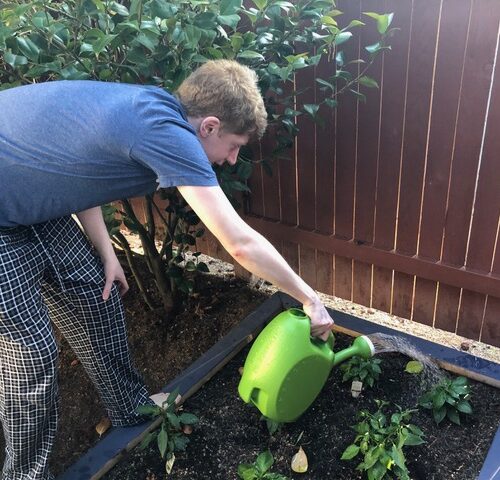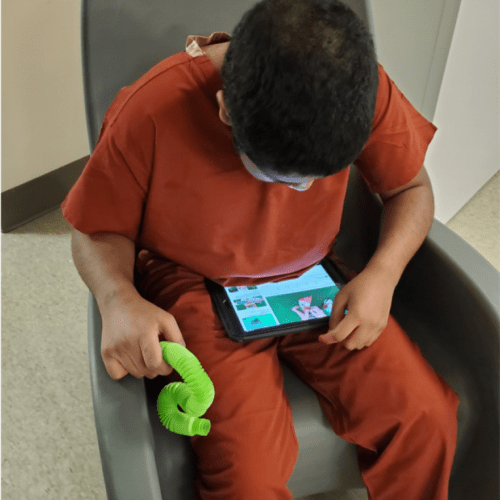Before the COVID pandemic struck in early 2020, Robin Marie’s son Brennan was attending a school in Issaquah for youth who are autistic. His needs were so great that he had two-to-one staff support.
At home in the afternoons, Brennan would work with a behavioral specialist. He also met regularly with a counselor, an occupational therapist and a speech pathologist.
But COVID upended all of that. Suddenly Brennan, who is a student in the Lake Washington School District east of Seattle, had to attend school virtually and meet with his therapists over Zoom.
The Northwest News Network is not using Brennan’s last name, which is different from his mother’s, to protect his privacy as a minor.
Marie said the disruption in routine and lack of support drove her “sweet and loving” son, who also struggles with severe anxiety, into crisis. Soon he was lashing out physically. First, she said, he destroyed three laptops. Then he turned on her.
“Brennan became so violent that I started to get injured,” said Marie, a single mom who also cares for a medically fragile older son.
Marie said Brennan broke her arm and then her nose. He also strangled her. She had to restrain him and call the police — multiple times. She said one officer told her to get Brennan help. Her answer back: there is no help. At least not in Washington.
At the end of 2020, she started talking with the Lake Washington School District about an out-of-state placement. Previously, Brennan had spent an academic year at a facility in Montana. This time it was decided he would go to Bayes Achievement Center, a residential treatment facility and school north of Houston, Texas. Robin said sending her son more than 2,000 miles from home was gut wrenching.
“You know it’s supposed to be the right thing for them, but every element of my body felt like it was the wrong thing. He’s leaving. He’s supposed to be here,” Marie said.
Brennan’s story highlights a gap in services for some of Washington’s most complex youth. It also reveals a below-the-radar aspect of the state’s special education system: students with severe behavioral challenges, including those with an autism diagnosis, being sent to out-of-state facilities at taxpayer expense. Some of these residential treatment facilities and boarding schools cost more than $300,000 a year, according to state records.
As of November 2021, 55 Washington students who were receiving special education services — including 25 who were eligible because of an autism diagnosis — were in residential settings; all but three of them at facilities outside the state, according to the Office of the Superintendent of Public Instruction (OSPI).
Local school districts can request reimbursement for out-of-state placements from OSPI’s safety net fund. Records show that during the 2020-21 school year, the total amount approved for out-of-state placements was $12.8 million, up from $2.77 million during the 2016-17 school year.
The state of Washington has a list of more than 50 pre-approved schools and programs in 19 states where out-of-state placements are allowed. The majority are in Utah, but other locations include New York, Massachusetts, Ohio, Kansas, Missouri, Colorado and Montana.
The list includes Heartspring, a boarding school for autistic youth in Wichita, Kansas; The King’s Daughter’s School in Columbia, Tennessee which serves students with developmental disabilities and Change Academy in Lake Ozark, Missouri which runs a program for youth who’ve experienced trauma.
The Northwest News Network first reported on out-of-state educational placements in December. In February, Investigate West published an in-depth report on the practice.
A last resort
While sending a child out of state is always a last resort, legal and educational experts say it’s sometimes the only option given a lack of adequate resources for families and high-needs students in Washington state.
“Sometimes the conversation is maybe not that it’s the best placement, but the necessary placement right now,” said Tania May, the state’s assistant superintendent for special education.
State and federal law require that when school districts can’t meet the needs of a child with disabilities, alternatives need to be offered. That includes placements outside Washington’s borders.
The Lake Washington School District, where Brennan is a student, currently has seven students at out-of-state facilities. Shannon Hitch, the district’s executive director of special services, said the decision to look out of state is made by a team and based on the intensity of the need of the student.
“It’s life-changing for that student, it is life-changing for that family, which is why we feel a mantle of responsibility to make the best decisions we possibly can for those kids,” Hitch said.
But for desperate families, getting a local school district to agree to send a student to a costly out-of-state facility isn’t always easy. As a result, some families turn to attorneys who specialize in this work to help them get approval.
“I think more often than not school districts are just reticent to say that they are unable to serve a student,” said Lara Hruska, a former educator and founding partner at Cedar Law in Seattle, a firm that specializes in education law.
Hruska said roughly half of her practice involves youth with developmental delays or autism and co-occurring behavioral issues. The other half is youth who are displaying destructive behaviors related to diagnoses such as trauma and depression.
Hruska said before an out-of-state placement is considered, first all in-state options are exhausted. But if it’s determined that a child would benefit from a therapeutic residential placement, then the search becomes a national one.
There are several theories about why Washington doesn’t attract youth residential treatment providers, including the fact that state law gives children 13 and older autonomy over their behavioral health care.
“We’ve got quite Libertarian laws around age of consent, and students can sign themselves out of placements,” Hruska said. “I could see that as a disincentive for maybe some of these larger residential schools that have multiple locations to be here.”
For decades, Washington has also prioritized deinstitutionalizing people with disabilities. Many disability rights advocates argue that instead of residential treatment programs, Washington needs better community-based supports.
Ivanova Smith, who’s autistic and works with the self-advocacy groups People First of Washington and Self Advocates in Leadership, said Washington state has “dropped the ball” when it comes to supporting students with disabilities and their families.
“It angers me as a self advocate, it really frustrates me,” Smith said. “We all deserve freedom, we all deserve our civil liberties. But when there is not enough funding to support us in a community, that puts us in a really bad bind.”
The COVID effect
While it appears out-of-state placements have increased in recent years, it’s difficult to get an accurate picture because of a lack of tracking and incomplete data.
Hruska, the attorney, said in her experience the pandemic drove up demand for residential treatment because families of high needs kids lost access to in-person services.
“We had students who were in dire need of intensive therapeutic residential placement, where they might have been able to sustain or even make progress with the services as they were [before the pandemic],” Hruska said.
OSPI cautioned it’s too early to know for certain what effect COVID had on out-of-state placements. Earlier this year, the agency requested and Gov. Jay Inslee granted a veto of a budget provision that would have required OSPI to submit an annual report on out-of-state special education placements.
An OSPI spokesperson told the Northwest News Network that the agency had a number of concerns about the new reporting requirement and said the agency “already collects much of these data and we are happy to make those available when requested.”
The trend in out-of-state placements is just one piece of the puzzle. There’s also the question of equity considering that not all families can afford to hire an attorney to help advocate for them. That can exacerbate inequities and create a situation where students from wealthier districts are more likely to secure a placement.
In Robin Marie’s case, she said she borrowed from her retirement and took out loans to hire Hruska to advocate for her family.
While Hruska’s firm does pro bono work, she acknowledged there’s a gap in access for special education families. In an effort to begin to address that, she said advocates have undertaken efforts such as offering free training to parents of special education students to advise them of their rights.
“All the inequity that we deal with as a society gets really concentrated when you do these questions, these really difficult questions about children and disability,” Hruska said.
In addition to legal barriers, desperate families face the challenge of navigating multiple systems of care — all of which are stressed — to get their children help.
“It’s not just the school system. It’s the developmental disability system and the mental health system too that need to be adjusted,” said Mary Griffin, a special education attorney with the Seattle law firm Johnston George.
The issue of out-of-state placements is on the radar of state lawmakers who, for years, have been working to shore up the state’s behavioral health system. The current state budget plows tens-of-millions more into higher reimbursement rates for providers and to expand access to crisis stabilization services — both in the behavioral health and developmental disabilities realms.
But advocates say it will take much more to create a holistic safety net, especially for youth with an autism diagnosis.
“We’re failing autistic kids,” said Adrienne Stuart, the director of public policy at the Washington State Developmental Disabilities Council.
Stuart noted that Washington ranks among the lowest states in the country for ensuring kids with developmental disabilities are served in general education settings.
In extreme cases, these youth end up stuck in the hospital, or cycling in and out of the hospital, with nowhere to go.
That was the case for Theresa DeMonte’s teenage son Noah who in 2016 and 2017 spent an estimated 70 days hospitalized at Seattle Children’s Psychiatry and Behavioral Medicine Unit.
Eventually, Noah was approved for a slot at The New England Center for Children, an autism research and education facility in Massachusetts, where he’s been ever since.
“There were times that he could be very sweet and very joyful, but ultimately we weren’t able to provide the structure and extreme supervision and behavioral management that he needs to be successful,” DeMonte said.
Five years later, DeMonte said Noah is doing “really well” and her family feels lucky he was able to go to a residential school, especially since not all families are able to access the same level of care. But she also said the fact her son is living on the other side of the country is unfortunate.
“It doesn’t feel lucky like winning the lottery,” DeMonte said. “It feels more like getting the chemotherapy you need when you have cancer, which should be available to everyone who needs it.”
Noah is now 20 and close to “aging-out” of the education system. The next challenge his family faces is deciding where he will live once he turns 21.
Robin Marie also feels fortunate her son is in a residential setting and is showing signs of stability. But she said the distance between Washington and Texas is taking a toll on both of them. While she’s been able to visit Brennan three times in the 15 months since he left, mostly they are limited to 20 minute chats via FaceTime once a week.
“Every time I talk to him, he asks me when he’s going to come home and I don’t have an answer to that,” Marie said. “And it’s heartbreaking every single time.”




















